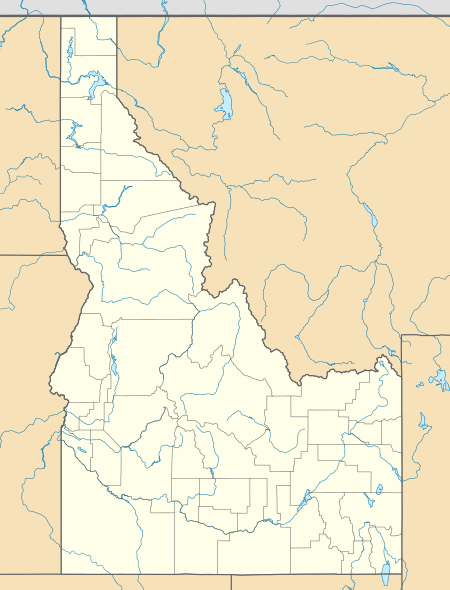Gibbonsville, Idaho
Gibbonsville is an unincorporated community in Lemhi County, Idaho, United States. Gibbonsville is 26 miles (42 km) north of Salmon. Gibbonsville has a post office with ZIP code 83463.[2]
Gibbonsville, Idaho | |
|---|---|
 Gibbonsville  Gibbonsville | |
| Coordinates: 45°33′20″N 113°55′23″W | |
| Country | United States |
| State | Idaho |
| County | Lemhi |
| Elevation | 4,570 ft (1,390 m) |
| Time zone | UTC-7 (Mountain (MST)) |
| • Summer (DST) | UTC-6 (MDT) |
| ZIP code | 83463 |
| Area code(s) | 208, 986 |
| GNIS feature ID | 396546[1] |
History
Gibbonsville is named for John Gibbon.[3]
Climate
Gibbonsville, nestled in the Bitterroot Mountains, has a climate rather typical of its region, although it is warmer than stations located at higher elevations. The climate is of the Warm Summer Humid Continental type (Köppen Dfb), but is quite different than most climates with this classification, owing to characteristics shared with its climactic brethren in the Bitterroot range, as well as parts of Wyoming and Montana (foremost among them being West Yellowstone, Montana), such as the high daily ranges of temperature throughout the year, being 18.6 degrees Fahrenheit (10.3 °C) in December, rising to nearly 40 degrees Fahrenheit (22.2 °C) in July. Also in July and the rest of the Summer, nights remain cool, averaging between 40 °F (4 °C) and 45 °F (7 °C), despite warm to hot afternoon highs, a characteristic of locations throughout the Bitterroots, the Teton Range, and Yellowstone Plateau. Although Gibbonsville does not have true wet and dry seasons, there is significantly more precipitation in winter than summer. Snowfall averages around 80 inches per year, a hefty average compared with most of the U.S., but rather typical for its region. The average of 80 inches usually falls between November and April, with January being the snowiest month.
| Climate data for Gibbonsville, Idaho (1895-2010) | |||||||||||||
|---|---|---|---|---|---|---|---|---|---|---|---|---|---|
| Month | Jan | Feb | Mar | Apr | May | Jun | Jul | Aug | Sep | Oct | Nov | Dec | Year |
| Average high °F (°C) | 28.7 (−1.8) |
36.4 (2.4) |
46.2 (7.9) |
56.6 (13.7) |
66.0 (18.9) |
73.8 (23.2) |
85.2 (29.6) |
83.5 (28.6) |
72.6 (22.6) |
58.9 (14.9) |
40.3 (4.6) |
28.7 (−1.8) |
56.4 (13.6) |
| Average low °F (°C) | 9.0 (−12.8) |
13.1 (−10.5) |
20.5 (−6.4) |
28.1 (−2.2) |
34.5 (1.4) |
40.7 (4.8) |
45.3 (7.4) |
43.7 (6.5) |
36.4 (2.4) |
28.5 (−1.9) |
21.1 (−6.1) |
10.1 (−12.2) |
27.6 (−2.4) |
| Average precipitation inches (mm) | 2.03 (52) |
1.15 (29) |
0.95 (24) |
1.12 (28) |
1.71 (43) |
1.91 (49) |
0.88 (22) |
1.02 (26) |
1.05 (27) |
0.89 (23) |
1.61 (41) |
1.94 (49) |
16.26 (413) |
| Average snowfall inches (cm) | 24.9 (63) |
11.5 (29) |
5.8 (15) |
2.4 (6.1) |
0.3 (0.76) |
0 (0) |
0 (0) |
0 (0) |
0 (0) |
0.6 (1.5) |
11.8 (30) |
23.0 (58) |
80.4 (204) |
| Source: [4] | |||||||||||||
References
- "US Board on Geographic Names". United States Geological Survey. 2007-10-25. Retrieved 2008-01-31.
- ZIP Code Lookup
- Gannett, Henry (1905). The Origin of Certain Place Names in the United States. Govt. Print. Off. pp. 137.
- "Gibbonsville, Idaho Climate Summary". Western Regional Climate Center. Retrieved November 15, 2011.